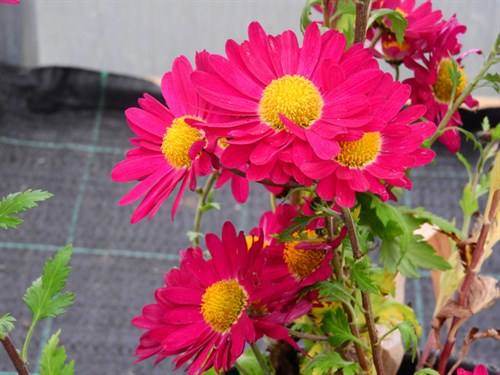Dull November brings the blast, then the leaves are falling fast
Monday, November 30, 2015
The lines in the headline to this News Item were written by Sara
Coleridge nearly 200 years ago. Although we are constantly being
told told that weather patterns are changing her description
of November perfectly describes the current month. After 2 months
of unbroken Indian Summer it came as quite a shock when the
settled weather came to an end to be replaced with torrential rain
and howling gales. We didn't like it too much and neither did most
of the plants! It has therefore been a struggle to find some
newsworthy events, but there are always a few if you dig deeply
enough. I hope you will enjoy reading about those I have
chosen.
The only leaves left on the trees now belong to the
larch in the surrounding woodlands highlighted here by the rare
evening sunshine and the rising moon.

Weather
The first 2 days of the month were idyllic, still, sunny
and warm. Lunch outside in shirtsleeves thinking that summer's
lease would never end. And then BANG! Wave after wave of mostly
westerly gales the best direction for us, as because of the lie of
the land, they generally go over the top of us reducing their
severity. Rain every day until the end of the month, sufficient to
raise the levels of our stream and small river to their highest for
over a year.Days were however generally mild with many over 10C ,
warmest on 1st was 16.5C and the coldest was -5C on 23rd, our only
true frost of the autumn And just to complete a dull month
there was a dusting of snow on all the surrounding hillis on the
22nd.
Hoar frost on the faded sedum seedheads - they almost
seem to have been made for it.
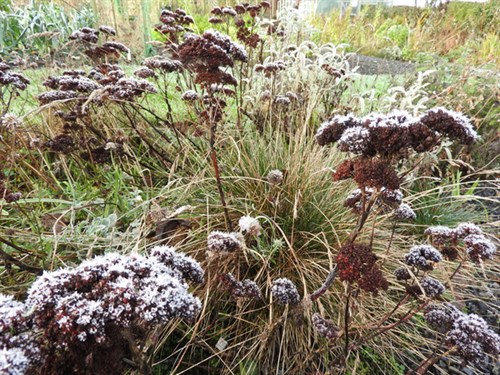
Garden update
Within the space of just a few days after the deluge began, all
the various forms of the daisy family (asters, sunflowers, dahlias,
chrysanthemums, achilleas and rudbeckias) started to give up the
ghost and the colour just drained from the borders, although a few
brave souls continued to put on a show. More on them later.
Mahonia media "Charity" a real thug of a shrub with
fiecely sharp spines on the leaves compensated for by scented
flowers to lift a dull November day followed later by intense
smokey purple berries.
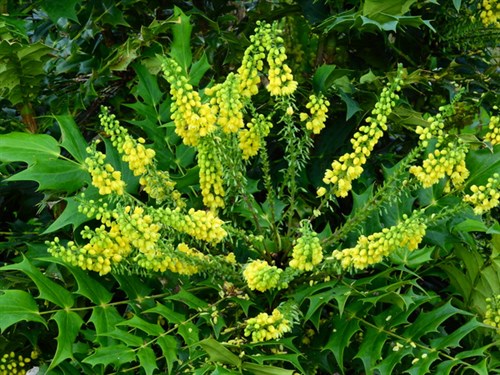
The wet weather prevented most of the gardening tasks I had
planned, and lawn mowing came to an abrupt end for the year. The
autumn/ winter feed that I applied a couple of months ago has
greened up the grass very well, which became even clearer, once I
could blow away all the leaves that had fallen. One major
clear up with my new blower, which saves an enormous amount of
time, which with care provides large piles of leaves with which to
cover the more tender plants such as impatiens, agapanthus and some
salvias.
Hellebores always send up a few flowers at this time of year but
all over the gardens there are plants in alnost full bloom.
My nurseryman friend and major hellebore breeder Richard Bramley of
Farmyard Niurseries for more info about the nursery visit the new
website at www.farmyardnurseries.co.uk
has had a sinmilar experience.
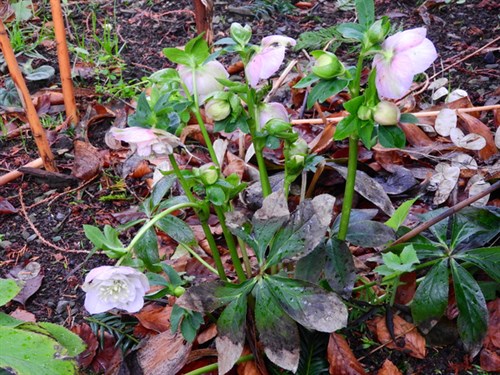
It was however a good time to repair nursery benches and
get more frost susceptible plants under cover. I also continued to
take cuttings of half hardies and to dig out and pot up some of the
parent plants to overwinter for early cuttings next spring when
they will get off to a better start than at this time of year when
they struggle even on the hot bench, botrytis being the major
problem
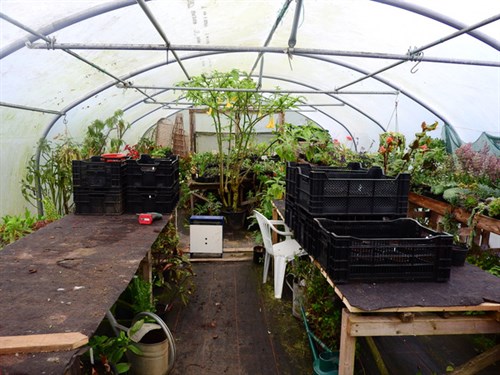
The tunnels are a great refuge on wet days and there is
always something to do there: tidying, cutting back, dividing
plants being overwintered, and latterly potting up spring flowering
bulbs including some of the smaller narcissus cultivars. I
fell in love with lily flowered tulips which I saw in gardens last
spring especially "Green Star" so have already planted some in the
few bare patches in the gardens, and a few more in pots. It may
seem heresy to say so but apart from a few selected forms and
species types, I am not a great tulip fan
When clearing out the tunnels I found tucked away in a
corner this lovely scented flower belonging to gladiolus murielae
(formerly acidanthera)

We had some of the best crops of vegetables we have had
all year during autumn with brassicas loving the rain, salad crops
too, late courgettes and sweetcorn and most unexpected of all was
the latest ever crop of runner beans from half a dozen plants of
"White Lady" I started from direct sown seed in the second week of
July. Another bean novelty was an autumn cropping broad bean called
Luz de Otono from plants supplied by D. T, Brown in mid August. I
was unsure how they would perform and in particular what insects
would be around to pollinate them but in the mild weather
there were plenty ofpollinators around and we had 2 crops of
small very tasty beans. I have since learned via the Internet that
seeds are also available from numerous suppliers and that the beans
can be sown to overwinter in addition to mid summer sowings for
autumn cropping. Both crops of beans were harvested on 19 November-
Amazing!!
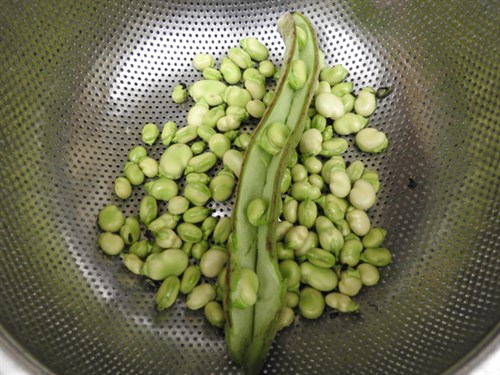

These caulis look a little tatty around the foliage but
for the 3rd week of the month what do you expect? The curds were
delicious in a variety of recipes of which there are plenty,
so popular has cauliflower now become.

Small salad potatoes from a planting in pots in the
polytunnels made in early August which was too late as the spuds
were tiny but there were enough to cook and they were delicious.
The variety is Venezia in my view the best tasting salad/early
potato ever!

What is (was) looking good during November
Not that much!!but there are a few stalwarts still keeping going
as the picture gallery below shows.
In the small tunnel grows a vigorous passiflora
mollissima which for the first time produced edible fruits which
give the plant its common name of the banana passionflower. In the
two pictures below are the unripe fruits of which there are about
20 on the plant and the glorious flower, the last one
left.
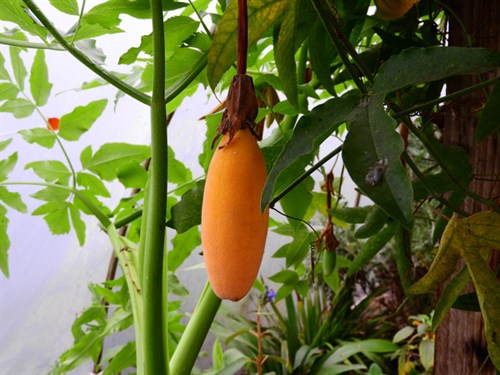
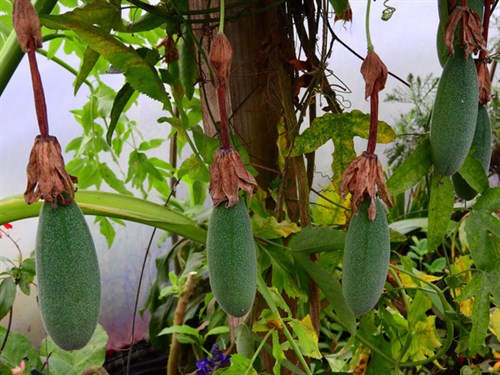
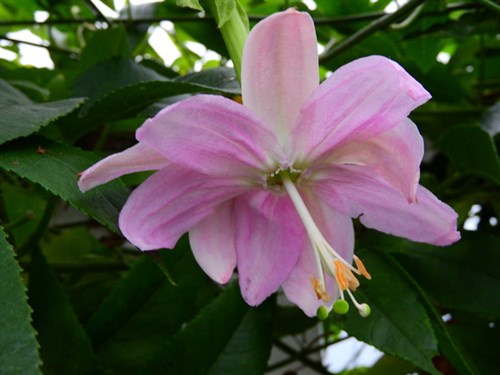
The attractive fruits of cornus kousa, one of my
favourite small trees which has reached 25 feet in the garden.
Glorious white bracted flowers in late spring turning pink, autumn
leaf colour and these unusual edible berries a little larger than
strawberries. Being a whimp I have not tried them yet but Wikipedia
confirms they are deliciously sweet and another website states they
taste like lychees. What more could you want from a garden
tree?
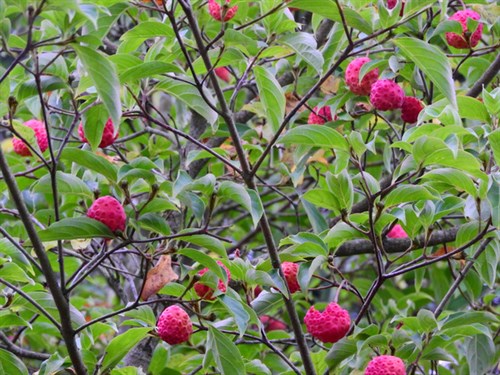
Nothing unusual about a sweet bell pepper but by sowing
in heat in early February this year I at last got some big ones but
they have taken a long time to ripen.

One genus to single out is the Japanese saxifragas which are an
ideal plant for late autumn coping with most extreme weather events
except frost. They are currently in vogue having been on trial at
the RHS Wisley and are the subject of articles in the current
editions of The RHS Journal and The Plantsman. It was from these
that I was introduced to their adopted common name of Autumn
Dancers which sums them up very well. Their large sprays of light
and airy flowers somewhat resembling a corps de ballet.
Saxifraga cortusifolia

Saxifraga fortunei "Rubrifolia" a personal favourite alongside
S. "Wada"
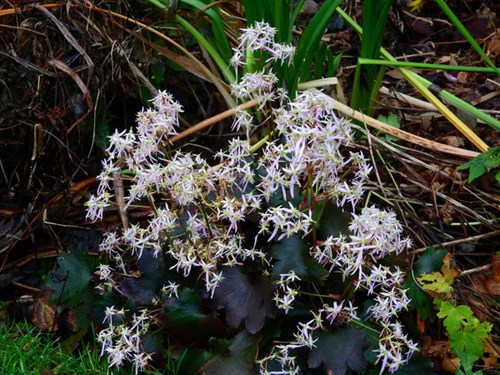
Saxifraga fortuneii "Blackberry and Apple" pie

Many hydrangeas are great value for late autumn colour
and if it stay mild will send up new flowers too. This is h.
"Peziosa" one of our all time favourites. The day after I took this
picture the sharp frost brought the show to an end.
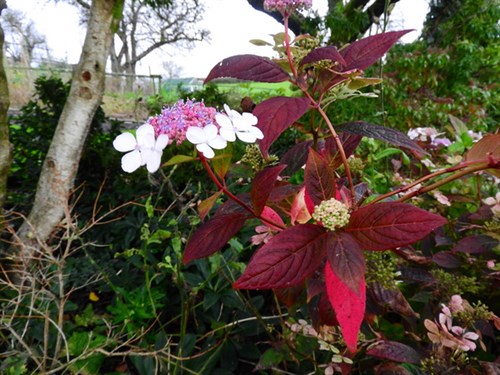
And this undoctored picture (honestly!) shows the
marvellous late colour on h. "Merveille Sanguine" Our acid soil
intensifies the leaf colour

A spent seedhead on agapanthus providing
architectural structure long after the flowers have
gone
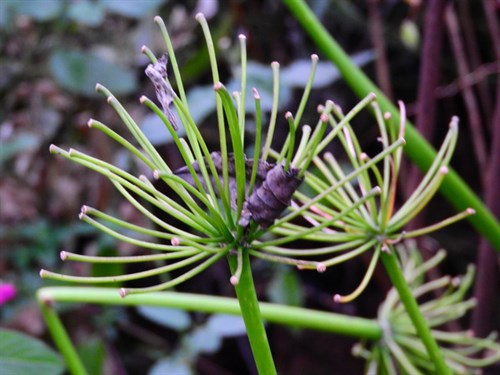
And believe it or not the large yellow brugmansia in the garden
by the conservatory, which I have raved about since mid summer
still had over 40 flowers on it when I moved it to the large tunnel
the day before the frost where it continues to flower!
Wildlife and countryside
Late autumn always seems to be the time when we have our first
visit of an otter to the Paddock Pond and this year was no
exception. Of course we rarely ever see them but tell tale signs of
fish scales on the bank along with spraints (otter faeces) confirm
it. Time to put up the electric fence.
Towards the end of the month I saw my first flock of redwings
and a small murmuring of starlings, both of which were
conspicuous by their absence this time last year
Despite the gales a few native trees hung onto their leaves, the
colours of which were highlighted in late afternoon sunshine which
has been in very short supply.
One group of local trees that haven't fared so well however is a
large stand of 60 year old larch in Cilgwyn Forest to the south
west of us which has been one of the best views we have. Sadly they
are all being cut down ahead of their time in attempt to halt the
march of phytophthora a fungal disease which is devastating larch
in many South Wales forests. Their fresh green colour in spring and
butter yellow autumn colours will be much missed and a large tract
of habitat for birds and wildlife will be lost
For more info go to www.forestry.gov.uk/forestry/infd-5ubesn

Visits
Just one talk this month to Drefach Felindre Gardening Club, my
last until the second week of a very busy February 2016
We did however for a change attend a talk at South
Wales Group of The Hardy Plant Society given by Fergus
Garrett the Head Gardener of Great Dixter on the subject of
"Succession Planting". It was a truly memorable experience packed
with new ideas for colour schemes and other planting ideas to
maximise the level of interest in borders throughout the seasons.
It was a wonderful opportunity too to learn more about one of the
truly great gardeners of the 20th Century, Christopher Lloyd
(Christo). Fergus worked with Christo for over 20 years and
he gave many examples of his background, family life,
character, kindness and unique talent. One particularly amusing
anecdote was that of Christo, controversial as always in his choice
of colour contrasts, deliberately choosing to stand in his borders
wearing a brightly coloured sweater just to clash with the flowers
in the borders to guage the reaction of visitors!
Supported by a battery of careful selected pictures and laced with
good humour, it was a masterclass in how to deliver a garden talk.
If you ever get the chance to attend one of his talks you must
go!
Not the best picture I would agree so apologies to
Fergus! but it was so busy it was difficult to get a clear picture
of him. I don't know what is the purpose of the frame on the stage,
but in a way it adds value to the picture because his talk was all
about changing the goalposts of border planting, colour and
structure.

And finally to cheer us all up a small posy of a vibrant
hardy chrysnthemum "Royal Command". Late chrysanths like this are
making a comeback after a long time in the gardening wilderness and
are tipped to become a must have plant. Welcome back old
friends.
